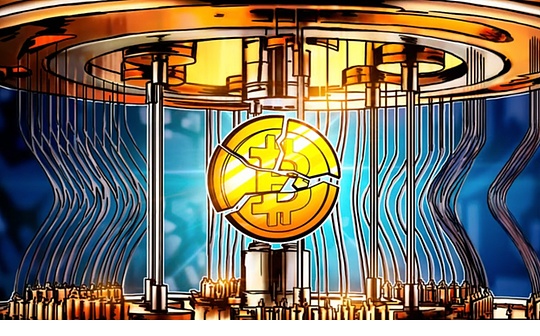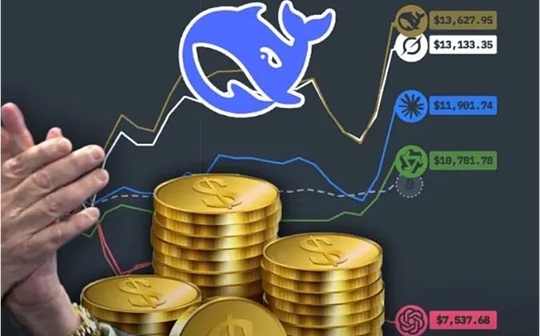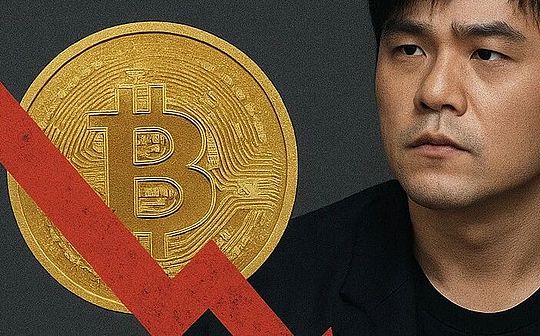
author:The Block,Compile:Azuma
Editor’s note: On October 11, the cryptocurrency market suffered an epic plunge. Although a week has passed, discussions surrounding the reasons for that day’s plunge and its subsequent impacts have not stopped.
On October 15, Evgeny Gaevoy, the founder and CEO of Wintermute, the industry’s most important market maker (there were thunderstorms on the Internet on the day of the crash, but the rumors were later refuted) participated in The Block’s podcast and gave his own views on the “1011” incident.
The following is the main content of this podcast. For the sake of reading fluency, the content has been deleted.
An hour of total chaos
Moderator: Let’s get straight to the point.What happened on October 11 was very shocking to the entire market.Can you take us back to what exactly happened that day?What triggered the plunge?How does Wintermute respond in such a situation?
Evgeny Gaevoy: To be honest, we still need more time to fully understand the ins and outs of this plunge, but one thing is clear—the trigger appears to be another series of Trump-related news, which gradually triggered the largest liquidation event in the entire history of cryptocurrency.
That day was an extremely unusual day for everyone—not just ordinary traders, but market makers as well.Within an hour, the market was completely out of order.
We’ll talk about the ADL mechanism later, and also how this crash differed from previous market moves.What is certain is that this day is very difficult and unprecedented for many people.
Still unclear who lost the most, perhaps the hedgers
Moderator: Public statistics show that approximately $19 billion was liquidated that day, but since Binance does not fully disclose the data (the system can only show one liquidation event per second), the actual number is likely to be much larger, at least between $25 and $30 billion.This means that the latest liquidation is more than five times larger than the previous second largest liquidation event.Why is this happening?Is it because the leverage in the system is too high?Or is some critical infrastructure failing?This makes it impossible for market makers like you to intervene in time to prevent a series of crashes.
Evgeny Gaevoy: I think it’s a combination of multiple factors.On the one hand, there is indeed more leverage in the system; on the other hand, the market also has more token categories, more perpetual contract products, and more large platforms for trading these perpetual contracts.Looking back three or four years ago, we did not have so many perpetual contract products with huge open interest and potential for huge crash risks.In terms of market maturity, although the overall situation is indeed more complete and more sophisticated than in the past, this development has also given rise to many problems.
At present, we still don’t know who was “exploded” and who suffered the most losses, but I suspect that many institutions with serious losses are actually running long-short strategies. For example, they may short Bitcoin and long certain altcoins. They thought this could hedge risks, but they were “slapped in the face” by the ADL mechanism.
In addition, when the market experiences extreme declines, various trading paths tend to get stuck.This is especially troublesome for market makers.For example, if you buy on Binance and sell on Coinbase, you will find that you have more and more stable coins on Coinbase, but you have received a lot of tokens on Binance—but at this time, the withdrawals on both sides are blocked, and you cannot transfer assets at all.
Therefore, when people say “market makers have withdrawn from the market and are unwilling to provide liquidity”, it is more often than not “unwilling”, but “cannot do it at all” – they can neither quote here nor place orders there, because the assets cannot move at all.This situation doesn’t only happen with centralized exchanges (CEX), DeFi is not immune either.This is the toughest crux – you simply can’t adjust positions across platforms.
Insufficient ADL leads to confusion
Moderator: You mentioned ADL (automatic deleveraging), and I guess maybe 90% of cryptocurrency users have heard of this term for the first time.Can you explain how ADL works and why it caused so much confusion in this incident?Also, what impact does this have on market efficiency when market makers are unable to be active on multiple exchanges simultaneously?
Evgeny Gaevoy: ADL (Auto-Deleveraging) is essentially the “last line of defense” mechanism for exchanges.Under normal circumstances, when the margin of the perpetual contract position you hold is insufficient, the exchange will directly liquidate your position in the market; if the liquidation is unsuccessful, the insurance fund should bear the loss.
The ADL mechanism is often not triggered at all, and many exchanges have not used it in years.It was designed as a “last resort” measure.In extreme cases, such as large-scale declines and serial liquidations like 1011, if positions are continued to be forcibly liquidated through the order book, the price may directly hit “zero”, the entire exchange will become insolvent, and short sellers will make huge profits.Therefore, the exchange will try to use ADL to forcefully offset part of the short positions, which is equivalent to letting the system artificially match the short positions with the exposed long positions, forming a “virtual offset” to prevent the price from completely collapsing.
In theory, this is an “elegant” solution, but the premise is that the execution must be orderly, and this time it was obviously very chaotic.The biggest question is—how is the execution price of ADL determined?This will become the focus of inquiries from many trading institutions to the exchange in the coming days and even weeks.
This time, the positions of many institutions were passively closed at extremely outrageous prices.Taking us as an example, some ADL prices are completely illogical, the market price is $1, and our short order was forced to be closed by the system at a price of $5.There is no way to hedge this, you can only suffer a dumb loss instantly.
Is there any “ADL-free” privilege?
Moderator: As far as I know, Ethena has ADL-free terms with certain exchanges.Can large market makers like you get similar protection?Why does Ethena get such special treatment?
Evgeny Gaevoy: First of all I’m not entirely sure if Ethena has this privilege.It should also be noted that Ethena mainly only trades BTC and ETH, and these mainstream currencies themselves rarely trigger ADL.ADL works more on various altcoins and meme coins.Of course we would be happy if such a protection mechanism existed.
But should exchanges make such terms widely available?Not necessarily. I think if it is implemented, it must be open and transparent. Investors need to know which open positions enjoy ADL-free privileges, otherwise a bad market structure will be formed.Of course we welcome such protection, but the premise is that a highly transparent disclosure mechanism must be established, otherwise the so-called privilege is just a conspiracy theory.
Another key point that is rarely discussed is that some exchanges (such as Coinbase and Kraken) have implemented market maker liquidity protection plans. The former FTX also had a similar design. This plan allowed market makers to take over positions that were about to be liquidated, bypassing insurance funds and ADL.Let the market makers with the most risk tolerance absorb these risks.However, on the mainstream platforms that have suffered large-scale liquidation this time, such plans are collectively absent. I believe that restarting such plans will greatly improve market resilience.
Does the market need to introduce a “circuit breaker mechanism”?
Moderator: There is also a theory circulating onSome people think that this may make it easier for some people to calculate, “We only need to hit the price here to trigger these liquidations,” thus artificially triggering a chain reaction of liquidations.In your opinion, is it really possible that this transparency has fueled this wave of liquidations, causing some assets to plummet 90% or more?
Evgeny Gaevoy: I think that if there was only one exchange in the world, Hyperliquid, then this conspiracy theory of “targeted sniping” might be more reasonable. In other words, there are indeed people who are specifically watching Hyperliquid to trigger this chain liquidation.But in fact, a large amount of open interest still exists on exchanges where liquidation points are not visible, so I think this statement is less likely to be true.
I think the more interesting point is, is Hyperliquid the future direction of the industry?In other words, is it possible that its mechanism of “all settlement points being publicly visible” can become an industry standard?
I personally believe that Hyperliquid should ultimately find a balance between transparency and privacy – the current information disclosure is indeed a bit “excessive”.One solution is to improve privacy; another potential solution is to introduce circuit breakers.
This feature is not available on all centralized exchanges, and although I can generally understand why, it really should be there.Especially for some stable assets or mainstream tokens, when you see it unanchoring to $0.6, it’s time to suspend trading or switch to auction mode, rather than letting it fall endlessly.
In the traditional financial market, almost every exchange—whether it is stocks, futures or commodities—is equipped with a circuit breaker mechanism.It will prevent the underlying asset from plummeting too much in a short period of time, and the system will automatically suspend trading or enter bidding mode, or a combination of both.But in the crypto market, no exchange has this mechanism, which has always puzzled me.If there is a circuit breaker mechanism, it can actually protect many retail investors from serial liquidations.
Of course, one might ask – if only one exchange (like Coinbase) adopts circuit breakers, but Binance does not, will it be useful?After all, a lot of price discovery actually happens on Binance.In this way, even if Coinbase stops trading, currency prices will continue to fluctuate on other platforms (including on-chain markets).So if only a single exchange adopts the circuit breaker mechanism, it may have limited effect.To be truly effective, most exchanges would have to adopt it collaboratively.
This is actually a trade-off issue.You have to choose between two risks: Let the price plummet and liquidate all your long positions?Or choose to suspend trading and ensure that the exchange maintains solvency?
For example, if Bitcoin plummets by 20% on an exchange, as an exchange, you can completely judge that this is an abnormal fluctuation rather than a collapse of fundamentals. At this time, it is reasonable to activate a circuit breaker; but if an altcoin drops by 50%, it may be a normal fluctuation and the market can clear itself.Therefore, circuit breakers should be introduced at least on specific trading pairs or asset types.
Will the exchange take the initiative to “unplug the network cable”?
Host: There were rumors in the past that some exchanges would “pretend to be down” but were actually triggering circuit breakers artificially.For example, during the 2020 epidemic crash, BitMEX went offline during the crash. At that time, the market generally speculated that they did this to avoid a 99% price plunge.Do you think this was a real circuit breaker at that time?Or is it just because the technical architecture cannot support it?Further, why are exchanges like Binance still down?Knowing that there will be a huge wave of transaction demand, but still not improving?
Evgeny Gaevoy: I tend to think that the simplest explanation is often the correct one.In my opinion, the reason is simple—the infrastructure of most centralized exchanges is poor and far from the technical level of traditional financial markets (such as the Chicago Stock Exchange, New York Stock Exchange, and Nasdaq).Although there are historical reasons, no one will actually migrate to a NASDAQ-level technical architecture in the short term.
It is precisely because the technical level is so backward that these platforms often crash directly under high load.I think this is a more reasonable explanation than any conspiracy theory.I don’t think the exchange will deliberately “go down and liquidate retail investors” to make money from the insurance fund. That would be too risky.
From a business perspective, it is far more profitable for exchanges and market makers to allow retail investors to continue trading, play games repeatedly, and retain them for a long time than to “purge retail investors every year.”Because once everyone is emptied, many people will leave completely and never come back.
Will there be a thunderstorm in the organization?
Host: I still remember the time Luna collapsed. Although it was not as serious as this time, the impact was still profound.It took us about two or three weeks to find out that Three Arrows Capital (3AC) was actually bankrupt.And this liquidation is 5 to 10 times larger than that time.Although there are speculations from the outside that some market makers, trading companies, and lending institutions have been hit hard, so far, no one has heard of a complete liquidation or bankruptcy. At most, I have heard that a few trading companies “lost a little money.”Do you think any institution will be caught in a storm next?After all, both open interest and liquidation levels hit records this time.
Evgeny Gaevoy: I think the market is a lot less interconnected now than it was in 2022.At that time, Three Arrows collapsed, and the entire market was directly dragged down by its long positions.
Now if a market maker does go bankrupt, you should ask who will it affect?How long is the chain of influence?What everyone is most worried about is actually the “contagion effect.”Remember what Alameda did?When they rebounded, they began to sell off assets on DeFi crazily. Everyone can see it, it is very obvious.
What would happen if the market maker did go bankrupt, say, Wintermute—and this is just a hypothesis—then what would happen?We have some loans, and those may all become zero; we also have some market-making contracts signed with the agreement, and these may still be there; after bankruptcy, we can theoretically sell part of the assets to recover funds, or run away directly (joking); in addition, we also have settlement counterparties, who may have deposits with us, such as BTC or ETH.
Therefore, the real scope of influence mainly includes the protocols served by the market maker and the counterparties that have margin transactions with the market maker.The worst-case scenario is that they sell their BTC or ETH in order to cash out, but the scope of this situation is actually very limited.
If some smaller market makers may really be “destroyed”, they may sell some specific tokens in their hands, such as the project tokens they are responsible for market making, but to be honest, this usually does not help, because the liquidity of these tokens is limited, and the sell-off is too obvious, and the market will notice it immediately.
So overall, the scope of infection this time is very limited compared to 2022.At that time, things like Three Arrows lent money to Genesis, Genesis borrowed money from Gemini, the whole industry was implicated in each other, and finally a series of bankruptcies, but now the system is much cleaner and the risks are better isolated.
Experience and lessons after extreme market conditions
Moderator: Do you have any reflections or lessons learned after this incident?For example, is there any room for improvement in response strategies, risk control or hedging mechanisms?
Evgeny Gaevoy: The challenge with these types of events is that they may only happen once a year, two years.You can learn a lot from it, but it may not be cost-effective to invest a lot of resources in optimizing this kind of “black swan”.
In fact, many market makers simply quit the market this time because such extreme market conditions are simply not suitable for their systems.We are still there, but we are only participating with a very limited position—the inventory problem mentioned earlier limits our operating space.Although this is not the first time we have encountered this situation, this time it is indeed more difficult than before.If you add in ADL (automatic deleveraging), it gets even trickier.
One thing we did learn from this experience was to be better at handling ADL incidents.Although our system responds very quickly, it can immediately detect changes in open positions and automatically adjust positions.But when you receive 500 ADL emails from Binance, you still have to manage them manually.Of course you can also design a perfect system that automatically trades perfectly in this extreme situation, but this is meaningless for the other 364 days of the year and is not worth investing in.
We also held a meeting this morning to discuss the next improvement. For example, in the quotation system, we have a large number of “circuit breakers” internally. This time they were triggered too frequently and were disconnected almost every minute.We may make it less aggressive in future extreme markets.
Overall, we are satisfied with our response.Although I made some losses on ADL, I also made a lot of money due to the high volatility. After offsetting each other, the overall performance was good.Of course it could be better, but overall it’s okay.
What’s annoying is that there is a lot of FUD now, and we spend a lot of time communicating with counterparties, cooperation agreements, explaining our inventory status, etc.Although this is troublesome, it is understandable – after all, everyone is nervous.
What are the market outlook expectations?
Host: So, looking ahead to the next few months, what do you think?The scale of this liquidation hit a record, far exceeding FTX, Luna and other incidents, but no one seemed to think it was “the end of the world” this time, but many people suffered heavy losses.
Evgeny Gaevoy: I think the main impact in the next few months will be: sectors other than major currencies will be affected, because this liquidation is mainly concentrated on altcoins.There are many more altcoins and meme coins on the market now than four years ago, and investors have less money and are more cautious, so I think the market popularity of altcoins will decline significantly.Of course, new retail investors enter the market every day, so the market will recover sooner or later, but in the short term, there will not be a big “altcoin season.”
On the contrary, it is worth noting that Bitcoin, Ethereum, and even Solana’s performance this time is very stable.For example, Cosmos (ATOM) once fell by 99.9%, while the maximum decline of BTC and ETH was only 15%, which was very mild.
Liquidity will further converge to BTC, ETH, and SOL
Moderator: Does this mean that the maturity of the market and the assets themselves has increased?
Evgeny Gaevoy: I think so.Bitcoin is now an institutional grade asset.There are ETFs, there’s MicroStrategy’s blessing, there’s infrastructure like CME futures.Ethereum is basically close to this status, and Solana is getting close too.
So I am not worried about any huge flash crash in BTC, unless there is a very strange black swan, such as a quantum computing attack.
This is actually a positive signal, indicating that some mainstream assets are “safe enough to hold for a long time.”The more ETFs and wider access channels, the more limited their volatility is, which means you can hold BTC, ETH, and even SOL with more confidence and higher leverage.In the future, we will also see more and more leverage and liquidity concentrated on these assets.
Wintremute’s emergency response mechanism
Host: Your people are mainly in London, right?Although you also have overseas offices, I would guess that most of your trading team and core members are based in London.The time when this market happened was quite late for London, almost at night or even early in the morning.So how do you deal with emergencies like this when your traders are sleeping?Will you have teams from other countries taking over immediately?How automated is trading today?How would you handle these emergencies if they happened at the worst possible time in your time zone?
Evgeny Gaevoy: Yes, we actually have to thank the “Trump rallies” for this. We have long been accustomed to this situation – extreme market conditions often occur on weekends or late on Friday night, London time.
So although this time was quite shocking, we were actually prepared.Of course, to be honest this sucks for a trader’s life balance, but that’s true in any trading firm.
Generally, we divide the work like this – the London office and the Singapore office relay.Around 10 to 11 pm London time, the Singapore team will take over the transaction, and the people in London will slowly start to “relax”, and this time the market broke out before the handover, so we didn’t have time to relax before everyone was involved.It was a very busy night indeed.
Host: I talked to another market maker and they said they have a device that wakes traders up at night if there is a big move in the market.I think that’s probably because they’re not as big as you and don’t have a global team relay.Will this happen to you too?For example, if an asset suddenly plummets by 15%, will anyone be woken up by the system?Or are you spread far enough now that you can sleep peacefully?
Evgeny Gaevoy: Basically, I only get woken up when things get really bad and we lose a lot of money.So I actually slept pretty well that night.
I didn’t start processing the FUD until I woke up at 8am the next morning and saw a bunch of people on Twitter asking “are you guys dead?”The team barely slept that night, but I slept well.
This is also the “luxury” of running a large, proprietary trading (prop trading) firm – you have enough traders to take over, and you can sleep peacefully and deal with the problem the next day.
So if I get woken up at three in the morning, something really bad is going on.So far, this has not happened.
Thoughts on DeFi performance
Moderator: From this incident, have you discovered any special phenomena on the chain (DeFi)?Although you don’t have much activity in DeFi, you still have some operations.Is there anything that went wrong or surprised you this time?For example, I noticed that Aave performed very well during this crash, there were not many liquidations, and the system was quite robust.Compared to the past, DeFi is actually quite strong this time.
Evgeny Gaevoy: We see too bad a situation in DeFi over there.But it is true that DeFi also encounters the same problem as CeFi: insufficient inventory (inventory issue).
Our position is on Binance, but it cannot be transferred out, so everything that can be sold on DeFi is sold out, and everything that can be bought on Binance is bought, but we cannot transfer assets there and can only wait for the inventory to return.Of course, we could have borrowed assets to make the market, but that would be very risky and might lead to liquidation.Another way is to quote different prices for USDC in different markets (such as DeFi and Binance) and do cross-market arbitrage, but that is also difficult to operate.
This kind of extreme event actually only happens once a year, and you can’t build a system specifically for it.We saw that most competitors simply stopped DeFi trading during this incident, possibly because their risk control circuit breakers were triggered.
I’m quite satisfied with our performance.Although it could have made more money, it did just run out of inventory.
About FUD
Moderator: Last question – Wintermute (WM) has almost become a “scapegoat” in the eyes of the encryption community.If there is any disturbance in the market, everyone will blame you.For example, someone discovered that you went to Binance to deposit hundreds of millions of dollars during the plunge, and immediately spread rumors that you were selling. In fact, I know that it was just a neutral arbitrage position (delta neutral trade), but the rumors were still flying everywhere.Do you still care about this kind of public opinion?Although you do not rely on retail investors or Twitter public opinion, you are more concerned about LPs (liquidity providers) and cooperation agreements.But how do you personally cope?Will you be angry?Or have you given up on it?
Evgeny Gaevoy: To be honest, I have completely looked away.I’m just sad that someone could be so stupid.They piece together unrelated pieces of data to draw ridiculous conclusions, and they feel confident about it.
For example, when someone saw that we deposited $700 million into Binance that day, they shouted “Wintermute is going to crash”, but they didn’t even notice that we also made a deposit of almost the same amount on the same day.These people are actually retail investors betting on altcoins — and we happen to be the ones making money from them.
So it’s an “ecological relationship” — they’re talking nonsense on crypto Twitter and we’re profiting from their stupidity.It’s a bit sad, but if they were smarter, our trading volume might actually go down.
We have been net long
Host: Will you consider expanding into businesses other than market making in the future?Like proprietary trading, investing, or something else?
Evgeny Gaevoy: In fact, we have always done some other businesses, but there is a misunderstanding from the outside world that we are short-selling every day.In fact we are almost always net long (long).
We are overall bullish starting in 2022 and perhaps even earlier.We have a venture capital department that has invested in many projects, and we have received a lot of locked tokens as a result.We also hold a large number of core assets such as BTC, ETH, HYPE, and SOL.We cannot smash the market because that will directly harm our own positions.
In terms of risk management, we have clear rules: our long position will not exceed 25% of our net assets. Even if the market collapses tomorrow, we will lose up to 25% and will not go bankrupt.We also don’t put more than 35% of our net worth on a single platform, so even if Binance went out of business tomorrow like FTX, we would still be alive.
This is why we survived the FTX crash and why we survived the hack.Unless the top five exchanges disappear at the same time, we can all survive.







